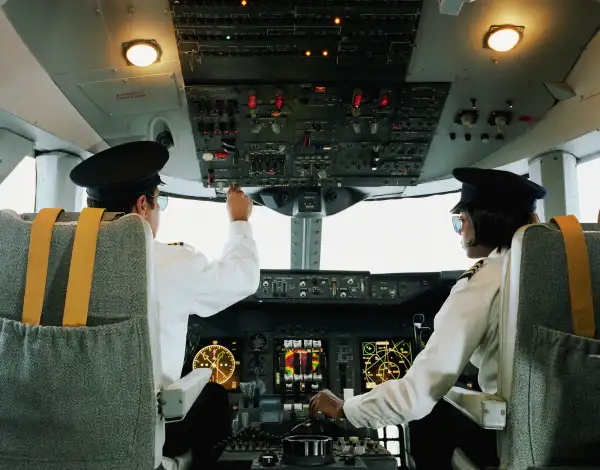Here's How Much Airline Pilots Really Make

Most of us know how much airline tickets cost, but what about how much the pilot flying your plane makes?
As it turns out, right now is a good time to be an airline pilot when it comes to negotiating salaries. Airline profits are sky high — expected to reach a net profit of $38.4 billion in 2018 ($4 billion more than 2017) — and have been boosted by economic growth and more people flying and shipping cargo on planes than ever.
On top of the increased demand for air travel, the airline industry is in the midst of a pilot shortage, stemming in part from 2009 Federal Aviation Administration (FAA) regulations requiring pilots to log more hours of training and take more time to rest in between flights, meaning airline pilots are flying less than they used to. These changes happened at the same time a large number of pilots began retiring, which means airlines also need to hire more pilots to replace the retirees.
All these conditions give airline pilots and their unions a lot of leverage in negotiating better pay packages to get the best salaries and benefits possible as airlines look to not only keep current pilots happy, but also recruit more.
The average U.S. airline pilot salary is $113,709, according to Glassdoor — and their contracts tend to last three or four years. Most well-known airlines actually pay more than the average, Glassdoor data shows: Delta Air Lines pilots make about $137,500 annually, while American Airlines pilots come in around $141,200. But United Airlines beats them both, coming in at an average pilot salary of $178,100.
Here's a closer look at how much airline pilots make based on a variety of factors, including plane size and route.
Commercial airline pilot salary
Aside from the basic contract negotiations, there are numerous factors that determine how much airline pilots make including the size of the airplane they typically fly.
“If you fly a bigger airplane with more passengers, you get paid more,” said Brian Sumers, an airline industry expert at Skift, a travel intelligence media company.
So how do you get to fly one of the bigger planes? “Seniority is the name of the game,” Sumers says. "The longer you've been at an airline, the more seniority you have, so most pilots tend to stick with one airline once they work there."
A little-known fact about airline pilot pay is that they are paid hourly. Federal law mandates that pilots can only fly 1,000 hours a year to ensure they stay fresh on the job. The highest hourly wage is $320 for flying a Boeing 777 — one of the biggest planes there is, measuring in at nearly 210 feet long with the ability to transport about 400 passengers — and those flights usually go to the more senior airline pilots.
So how much a pilot makes is largely based on how long they've been in the business, how many hours they fly and what type of planes they are flying.
"Some of the cushiest gigs are the super long-haul flights to Asia or Australia because it might be 15 hours one way and 15 hours back," Sumers said. "So that's 30 hours of flying in just two trips."
Private airline pilot salary
The same federal rules that apply to commercial airline pilots also hold true for those who fly private planes — they're not allowed to fly more than 1,000 hours per year. But one difference is commercial pilots are mandated by the FAA to retire at 65, after which those who want to keep flying sometimes transition to working as private pilots.
Private pilots are paid similarly to commercial airline pilots — for example, private jet company NetJets pays its pilots an average of $111,800 a year, according to Glassdoor.
Many of these private jet companies, including NetJets and Flexjet, pay by the hour and are unionized. Delta Private Jets, a subsidiary of Delta Air Lines, isn't unionized and their pilots are salaried — with captains making at least $100,000 a year, according to Gary Hammes, the company's president.
"Some people like [being a private pilot] because of quality of life," Hammes said. "These guys have set schedules so they know they’re going to work eight days straight and then have six days off," unlike commercial pilots who sometimes don't know where they'll be assigned to fly until the last minute.
One of the other perks of being a private pilot? They get to fly to obscure airports around the world that, for the most part, commercial airlines don't go, Hammes said.
Regional vs. major airline salaries
Pilots for regional airlines, such as Delta Connection and American Eagle, tend to make much lower salaries than pilots for major airlines. For most airline pilots, working at regional airlines is usually a stepping stone to their next job.
Sumers estimates most regional airline pilots make around $50,000 annually. Because of the pilot shortage, regional airlines have been forced to sweeten the deal to make up for how little pilots make compared to others.
"The regional airlines are giving signing bonuses of maybe $15,000 in the first year to attract recruits," he said.
U.S. vs international airline pilots
For airline pilots who are willing to relocate, there are even bigger paydays to be had.
Some countries in the Middle East and Asia don't have enough trained pilots — China is especially in need of pilots — so they entice U.S. pilots to move by offering them a chance to make more money. "They recruit pilots to fly for Middle Eastern airlines like Emirates and Qatar Airways," Sumers said.
Emirates, which is headquartered in Dubai, currently offers captains monthly salaries of at least $16,000, in addition to either a monthly housing allowance of $4,377 or company provided housing. Pilots there get a minimum of eight days off each month as well.